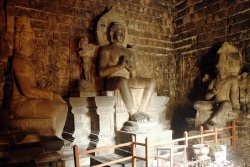Difference between revisions of "Ceremony of anointment"
Jump to navigation
Jump to search
(Created page with "thumb|250px| <poem> ceremony of anointment 灌頂 (Skt abhisheka; Jpn kanjo ) Also, anointment ceremony. A {{Wiki|ceremony}} common...") |
m (Text replacement - "Category:Japanese terminology" to "{{JapaneseTerminology}}") |
||
| Line 12: | Line 12: | ||
{{R}} | {{R}} | ||
[http://www.sgilibrary.org/search_dict.php?id=257 www.sgilibrary.org] | [http://www.sgilibrary.org/search_dict.php?id=257 www.sgilibrary.org] | ||
| − | + | {{JapaneseTerminology}} | |
[[Category:Rituals]] | [[Category:Rituals]] | ||
Latest revision as of 12:59, 27 April 2014
ceremony of anointment
灌頂 (Skt abhisheka; Jpn kanjo )
Also, anointment ceremony. A ceremony commonly performed in Esoteric Buddhism to invest the recipient with a certain status. The ceremony is said to have derived from the ancient Indian practice of pouring water on the heads of rulers when they ascended the throne. In Esoteric Buddhism, there are three kinds of anointment ceremonies, the respective purposes of which are
(1) to establish a relationship between the individual and the Buddha,
(2) to confer the status of practitioner of Esoteric Buddhism, and
(3) to invest a person with the rank of acharya, qualifying him to teach the esoteric doctrine.
